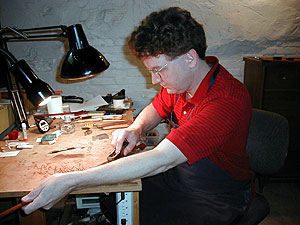|
Audio
Photos
More from MPR
Resources
Your Voice
|
The art of bow making
June 20, 2003
 |
| Bow maker Matt Wehling works away in his Northfield studio. Wehling makes roughly three bows a month, handcrafting each part. (MPR Photo/Erin Galbally) |
Northfield, Minn. — Matt Wehling's sparse studio is studded with precious objects. Gleaming white horse hair from Mongolia hangs in one corner. A big chunk of black ebony, and blocks of richly colored wood imported from Brazil sit on a workbench. These are what Wehling considers essential for making bows.
"Every step of the way you want to have a beautiful object in your hands and that way in the end you can't help but have a beautiful object in your hands," explains Wehling.
 | |||
Wehling says it's a lesson he learned during his six years in France. He says once he realized he wanted to become a bow maker, the move was inevitable.
"France is really the center of the world for bows. In the same way you have Stradivari (who) took the violin and perfected the form and elevated it to its highest level there's a French person who did the same thing with the bow," he says.
So Wehling settled in Brittany in the midsize town of Quimper. He studied hard and in time began to sell his own bows to a group of international clients. He married a French woman. They now have a three-year-old son. Wehling says moving back to Minnesota a couple of years ago was largely a business decision.
He makes roughly three bows a month for clients primarily in the U.S.
 | |||
"You can see it's a slow process. But as you get better it's a quicker process," says Wehling working away.
This is how each bow begins.
Wehling slides a special bow maker's plane across a strip of wood. He repeats this over and over and over again until a shape he desires emerges. To an unpracticed eye it's a stick, approximately a half an inch squared and about 28 inches long. But Wehling says it actually has the precise contours of an octagon essential to the art of bow making.
"I would then bend the bow using dry heat. I'll take an alcohol lamp and slowly but surely bend two-inch sections as I get all the way up to the end to have a nice even arch to the bow that I'll call camber," he explains, still bent over the wood.
Wehling says this is the most important part of the bow.
 | |||
"There's two major parts to a bow. There's the frog, which is this ebony part, which is very near to where the musician will hold the bow and then the stick," says Wehling. "The ebony part - the frog - I mean it's important but not nearly as important as having a really good stick. The stick is really what gives you the playability."
Unlike other parts of the bow, the stick is designed to last. Other parts can be replaced, but the stick is the backbone.
Wehling handcrafts every part of the bow. He cuts and carves the ebony. He makes inlay from thin layers of mother of pearl and mammoth ivory. And he creates the decorative gold or silver garniture that wraps elegantly around the polished stick.
Each bow is custom built with the individual needs of different musicians in mind. Wehling says many qualities combine to make each bow unique.
"There would be balance, there would be the camber of the bow, the strength of the bow, the nerviosite of the wood - which is not the same as the strength - its how difficult it is to push down the bow but also how quickly the bow comes back from a defermation," says Wehling.
 | |||
Robert Hanford is a violinist with the Minnesota orchestra. He's also one of Wehling's clients. Hanford says a good bow can play loud and soft, and it should be able to bounce.
He demonstrates.
Hanford's bow glides across the strings of his violin. Then he takes it a step faster.
Hanford says he tried out several bows before he decided on Wehlings. He says it was a perfect match.
"When I played on a few bows a while back for my wife she immediately said 'That one bow!' because every note sounds clear as a bell," says Hanford.
Wehling's bows don't come cheap. They range between $2,800 and $4,500. Still it's a fraction of the cost of older bows, made by French masters in the 1800s. They can fetch more than $100,000 at auction. Professional musicians need professional bows. And that's what Wehling, who's at the top of his craft provides.
"It's impossible to decide that you want to make bows that every player is going to want. Its like if you wanted to get a market share of 93% in the automobile market. Its just not possible to make a Mac truck and a Miata in the same bow," says Wehling. "You might get to where you understand these things and be able to make bows for all of those individual clients that fulfilled all of those things but what I'm interested in doing is making bows as I see them and trying to help people be as musical as they can."
|
News Headlines
|
Related Subjects
|
